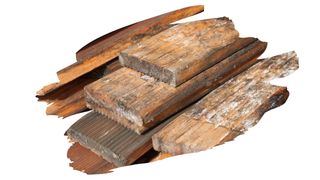Worried about the white mould growing underneath your hardwood floorboards? Or maybe you’ve tried a baking soda solution to get rid of it, but it’s had little to no effect. If so, then let me share a secret with you.
A little while back, I discovered that baking soda wasn’t the way to solve white mould. The solution? An altogether different kind of mineral salt called Borax.
Borax is much, much better than baking soda, when it comes to stopping the spread of white mold.
So, in this post, you will find out what’s causing that white mould in the first place. You will also learn why Baking Soda is often used as an anti-fungal solution. And we reveal why Borax is so much better than Baking Soda, when it comes to getting rid of mould.

This post may contain affiliate links to products that we receive a commission for (at no additional cost to you). Learn more here.
What Causes White Mould Underneath A House?
The main cause of white mould is moisture build-up, namely in the form of condensation and damp.
If you have a leaky pipe or a poorly ventilated floor space, water vapor can start to gather. And those damp warm underfloor conditions provide the perfect environment for fungi to thrive.
Related Post: Rotting Wood Around Your Sink? 3 Ways To Protect That Wooden Worktop
How Do You Treat Mould Underneath Hardwood Floors?
The best way to completely kill off fungi spores is to treat them with an alkaline solution.
Now, typically, people will use baking soda to do this. That is because this cleaning agent is a non-toxic salt with a pH level of 8. Which puts it just above the neutral line, when it comes to the acidic to alkaline scale.
But Why Does The pH Level Matter?
Well, pH levels measure just how acidic or alkaline (also referred to as ‘basic), a solution is. Something that has a pH level of 0 is wholly acidic. While something that has a pH level of 14 is wholly alkaline.
A solution that has a pH level of 7 is smack-dab in the middle, making it wholly neutral.
Now, white mould fungi like to live in pH neutral environments. Failing that, some types of bacteria can tolerate acidic environments too.
However, fungi does not last long in alkaline-soaked environments. And the more alkaline that solution, (i.e. the higher the pH), the worse it gets for them.
That’s why alkaline-based solutions are fantastic anti-fungal cleaners.
So, Baking Soda Should Work Right?
It can, but it is not quite strong enough to deal with more severe white mould spread. That is why you need something a little stronger in the form of a salt called Borax.
Although Borax and Baking Soda salts look similar, they are in fact very different. However, a key difference between them is their pH level.
Borax (sodium tetraborate) has a pH level that is more alkaline than Baking Soda (sodium bicarbonate). With a pH level of 9.5, Borax works much harder at attack the fungi responsible for all of that mould growth.
Related Post: Is Rotten Wood Good For A Compost Bin? (What To Do With Rotten Wood)
And How Does Borax Remove Mould From Underneath My Hardwood Floors?
You can use Borax in much the same way as you would Baking Soda. Simply mix 70 grams (1/2 a cup) of Borax with 1 litre (35 fluid ounces) of water.
Treat the mouldy area by dampening it with the Borax solution. And then use a scouring pad to remove as much of the mould as you can.
Quick Side Note: Try not to completely soak the area with the solution. You don’t want to risk wood rot taking hold in your hardwood floorboards.
Related Post: What To Do About Rotting Wood In Your Bathroom
Once done, don’t rinse and wipe the surface clean just yet. Leave that Borax solution for a further 1 to 1.5 hours, so it can work at stopping that mould for good.
Afterward, come back with a clean scouring pad and fresh water. And now you can go about removing the last of the more difficult to remove mould.
To Wrap Up, Here Are The 3 Key Takeaways From This Post…
- 1). White mould is often the result of moisture build-up. And dripping water and poor ventilation are typically the two most likely causes.
- 2). White mould can be removed by treating the mouldy area with a highly alkaline solution.
- 3). Baking soda has a high enough alkaline pH level to treat mild mould growth. But, for more severe mould spreads, use Borax instead. This natural mineral salt has a greater alkaline pH level than Baking Soda.
References:
Bandelin, F. J. “The effect of pH on the efficiency of various mould inhibiting compounds.” Journal of the American Pharmaceutical Association 47.10 (1958): 691-694.


